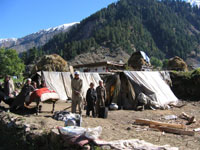The Earthquake in Pakistan: The School Responds (web article)
The ongoing relief work in Pakistan follows a general pattern, says Aamir Khan, MBBS, PhD ’05: Once search and recovery operations have been played out in a particular area, health workers move in to conduct needs assessments, then set up field clinics and, if possible, bring in mobile primary-care clinics.
From October 20–23, Khan, director of the Center for Community Development in Karachi and an associate in the Department of International Health at the Bloomberg School, accompanied a World Health Organization (WHO) team carrying out UN-sponsored health assessments in some of the most remote regions of the disaster area.

Photo credit: Aamir Khan
Says Khan of these efforts, “Although mission members travel by helicopter, this is taxing work, both physically and emotionally. The disaster area is huge and the scale of it can barely be comprehended by watching newsclips. The number and types of injuries is also appalling, as our surgeons have seen over 2,000 paraplegics in our field hospitals in Muzafarrabad and there is currently no capacity in the country to handle this many spinal injuries.”
Also on the ground in Pakistan: Irshad Shaikh, MD, MPH ’94, PhD ’00, with the WHO Health Emergency Operations Center, as well as an associate at the Center for Refugee and Disaster Response and the Department of International Health. Shaikh had been based in Nairobi, Kenya, at the time of the earthquake, working as a humanitarian-assistance epidemiologist with WHO; he was deployed to Pakistan within 24 hours of the quake.
Besides the above personnel, Khan notes that the Center for Refugee and Disaster Response's team is playing a crucial role, as are Lubna Samad and Zayed Yasin, who are helping procure supplies for the field hospitals and organizing rotations of medical teams. Syed Mahmood Ali Shah is supporting procurement of critical drugs/surgical supplies in the US.
Basic Equipment Is Badly Needed
Khan returned to Islamabad October 24 to begin serving as the temporary program manager for the WHO Communicable Disease Surveillance team (under the Health Emergency Operations Center) until a permanent replacement can be found, perhaps in two to four weeks.
He says that 25 GPS units are desperately needed for the surveillance field teams investigating outbreaks of measles and suspected cholera cases. Five satellite phones are also needed for the surveillance coordinators in each district.
"We need this equipment,” says Khan, “ because many or most of the physicians and health workers, or their family members, in the most severely affected districts perished, and there is a near-crippling lack of local information on both health facilities and the field maps commonly used by the polio immunization program. The disaster area spans over 18,000 sq km and that's a lot of ground for our teams to cover without local maps.”
Clinic Notes sent by Italo Subbarao from the Field
Italo Subbarao, a member of the original three-person team from the Johns Hopkins University Department of Emergency Medicine and the School, sends these notes from the field.
October 20. Mobile clinic was driven to the village of Sharrori and two other villages nearby, with a total population of approximately 2,000. Site was selected by informant interviews conducted by local Afghani medical team members with the IRC [International Rescue Committee]. Clinic was divided into male and female tents and staffed by one physician and nurse. One dispenser was also on hand to give out medications and instructions to the patients.
A total of 215 patients were seen within four hours. Chief complaints ranged from the common cold to pneumonia, chronic cardiovascular problems, fever and diarrhea. Female population reported higher numbers of kidney infections, headaches and dizziness. There were also increasing numbers of wounds incurred during earthquake that had become infected. Children had higher numbers of complaints of upper respiratory infection and vomiting/diarrhea. There was an underlying anxiety that permeated most complaints, including difficulty sleeping and difficulty eating, with no appetite, since the earthquake.
October 21. Needs assessments done on two Battal health centers—defined essentially as ambulatory care centers not offering surgery—near the city of Battal. One clinic was severely structurally damaged but no staff had been injured or killed and they had adequate medicines. The only need was for a large tent to serve as an operating room. The other health center was operational with minimal damage and no needs at this time.
Mobile clinic was set up in the villages around Shailkot (Battal), population 600. Two medical camps were also set up in two villages, one of these staffed by an Afghani medical team. A total of 160 patients were seen within three hours. The majority of the patients were females and children, with complaints ranging from dysentery to pneumonia to musculoskeletal problems. Complaints of muscular pain were due to initial injuries from blunt trauma incurred during the earthquake. Symptoms of anxiety (sleeplessness, decreased appetite) underlay many of the complaints.
